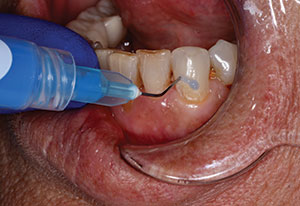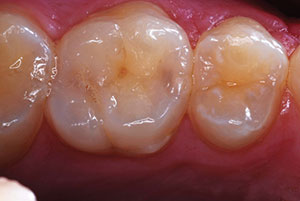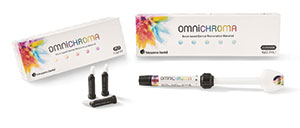INTRODUCTION
In many cases, choosing the best restorative solution for structural defects of the teeth is not an easy matter. The use of a composite resin material to restore function and aesthetics is known to be efficient. Direct restoration techniques using composite resin allow for greater preservation of healthy dental tissues,1,2 since only the tooth structure required to achieve aesthetic excellence is removed.
With the improvement of adhesive materials, this has become a common treatment option.3,4 However, as is the case with most dental materials, composite resins undergo deterioration and degradation in the oral environment throughout time (of course, this was observed more dramatically with the earlier generations of materials). As a result, discoloration, microleakage, wear, ditching at the margins, delamination, and fracture may occur, leading to the need for replacement.5
It is known that when a restoration is replaced, the cavity becomes larger, thus weakening the tooth. In addition, the restoration may become more complex, adjacent teeth may be damaged, and new defects may be introduced.6 Many professionals share the view that the presence of a defect (or surface staining) requires the removal of all existing defective restoration materials, and the fabrication of a new restoration may be required.7 However, composite resin restorations can be repaired, thus conserving natural tooth structure.8 Alternative treatments for the replacement of defective restorations (such as marginal sealing, renovation, and repair of existent restorations) improve their clinical properties and significantly increase their quality and longevity.9,10 Restoration repair also has the advantage of using less clinical time; it can sometimes be accomplished without the use of local anesthesia, and therefore may be less painful for the patient.6
This case report article will present an 18-year follow-up of a clinical case with patches of opacity restored using a direct composite resin technique.
CASE REPORT
A 49-year-old male patient sought treatment at the Faculty of Dentistry of Bauru, University of São Paulo, complaining of dark spots on his anterior and posterior teeth. A patient history, clinical examination, and radiographic evaluation were done, and the unaesthetic and discolored opacious areas in the teeth were obvious and noted (Figure 1). This unsightly condition was without apparent cause, as there was no report of it having occurred in deciduous dentition. However, the patient said that the opacity had been present since eruption of the permanent teeth and also reported taking antibiotics in his infancy, suggesting that it was most likely tetracycline staining.
 |
 |
| Figure 1. Preoperative photo showing the opacious and discolored tooth structure. |
 |
| Figure 2. Microabrasion was done in order to help diagnose the depth of the staining. It was confirmed that the staining compromised the entire enamel thickness, so direct composite resin restorations were the choice to treat this patient. |
Clinically, the mandibular incisors and the maxillary central incisors presented no alterations in the enamel structure, while the maxillary lateral incisors had a small degree of opacity. The shape of the teeth remained unchanged; however, they exhibited opaque, white-yellowish-brown patches of staining, and in the middle third of the incisal/occlusal surfaces, the enamel appeared to be smoother and thinner than usual, tending to fracture up to the dentin layer.
Clinical Protocol
The patient was informed about the direct technique procedures that would be required to improve the aesthetics of his smile, and that they would be done as conservatively as possible, obviating the need for a full-coverage option. After obtaining his consent, the clinical treatment plan was initiated.
 |
 |
| Figure 3. Preparations were done using spherical diamond burs (Nos. 1014 and 1016 [KG Sorensen]). |
 |
 |
| Figure 4. The restored teeth. |
 |
 |
| Figure 5. Post-op visit at 11 years. |
 |
 |
| Figure 6. Post-op visit in 2014; restorations fractured, worn, with a loss of some of the original brightness. |
 |
 |
| Figure 7. Final view of repaired restorations. |
First, the enamel of the lateral incisors was repaired. Microabrasion was done with a paste made from flour pumice mixed with 37% phosphoric acid (Tooth Conditioner Gel [DENTSPLY Caulk]) (Figure 2). Using a wooden spatula, this mixture was applied to a representative area of a tooth in order to help diagnose the depth of the staining.11,12 Since it was determined that the staining compromised the entire enamel thickness, it was decided to perform direct composite resin restorations.
The operative field was isolated, and the affected tooth enamel (maxillary lateral incisors, canines, first and second maxillary premolars, and mandibular canines, first and second mandibular premolars) was abraded with spherical diamond burs (Nos. 1014 and 1016 [KG Sorensen]) to obtain a uniform thickness (Figure 3), preserving the external aspects of the cusps. After the etching procedure (Tooth Conditioning Gel), a bonding adhesive (Adper Scotchbond Multi-Purpose Plus [3M]) was applied and hemi facets were made with microhybrid composite resin (Z100 [3M]) by the stratification technique. One week later, the restorations were finished and polished to yield the desired occlusal balance and comfort for the patient, achieving a fully satisfactory aesthetic result (Figure 4). The patient has also been followed up since, and some minor repairs have been made.
When the patient returned for a control visit in 2008 (11 years postoperatively) (Figure 5), only polishing was required. Most recently, after 18 years, the patient came back for another control visit, and the need for some restoration repairs was discovered, in addition to periodontal treatment. Initially, 5 sessions of prophylaxis (manual scaling) were performed. However, in the mandibular anterior region, deep scaling was required during periodontal surgery.
After the healing period, the restorative phase was initiated (Figure 6). In keeping with the philosophy of the initial conservative treatment, repairs were performed on the maxillary teeth previously described. The incisal edges of the mandibular canines were reshaped to restore anterior disclusion. These procedures were performed by selective grinding with spherical diamond burs (Nos. 1012 and 1014 [KG Sorensen]) in the discontinuous region of the restorations (worn or fractured). After this, acid etching was performed for 30 seconds with 37% phosphoric acid (Tooth Conditioner Gel). Then, 2% chlorhexidine (such as Paroex [Butler]) was applied actively on the exposed dentin for 60 seconds and, at the end of the period, prescribed dentin was dried with absorbent paper to remove the excess. Subsequently the bonding adhesive (Adper Scotchbond Multi-Purpose Plus) was applied and light polymerized for 20 seconds, then, repairs were made with a nanoparticle direct composite resin (Filtek Z350 XT Universal Restorative [3M]). A composite layering technique was used, with each layer being light polymerized for 20 seconds with an LED curing light (Radii [SDI]). Then the occlusion was evaluated and adjusted as needed. Canine guidance was checked to make sure that all the posterior teeth disoccluded properly in eccentric mandibular movements. Contouring and finishing were accomplished with finishing burs (Composite Finishing Bur Kit [Ultradent Products]). Lastly, disks, points, cups (Jiffy Polishers and Jiffy HiShine [Ultradent Products]), and diamond polishing paste (Mint Diamond Polish [Ultradent Products]) were used to create a high final polish on the restorations.
Upon conclusion of the treatment, normal function and aesthetics of the teeth (Figure 7) had been realized. Adequate oral hygiene care was strongly emphasized, and the patient was asked to continue to return for routine postoperative checks and preventative services.
DISCUSSION
Unaesthetic smiles caused by areas of hypomineralized enamel can be restored by direct or indirect restorations. The use of direct composite resin is becoming increasingly popular due to the continuing improvement in adhesive materials3,4 and because minimally invasive techniques help to preserve healthy tooth structure.1,2 Another advantage of composite resin is that it can be repaired; fractures and defects are fixable throughout time, and this work can be carried out relatively easily and inexpensively. In addition, this approach conserves tooth tissue, and minimizes the need to redo the entire restoration.8
As can be seen in this 18-year follow-up report, maintenance treatment was essential for the long-term success of the case. During the course of this period, several restorations were still satisfactory, some needing only polishing and others minor repairs. By making these small repairs, polishing restorations, and monitoring canine guidance (as emphasized by Dietschi and Argente13), greater longevity of the restorations was achieved.
In addition, this demonstrates a case in which monitoring allowed the feasibility of the chosen treatment to be assessed, and established satisfactory function and aesthetics for the patient throughout the years.
IN SUMMARY
In this case example, the use of direct composite resin allowed for a relatively simple, conservative treatment that provided excellent function and aesthetics, while preserving healthy dental tissue. The importance of continued follow-up and a periodic maintenance and minor repair process will ensure longevity of the restorations, the aesthetics, and the occlusion.
References
- Reis A, Higashi C, Loguercio AD. Re-anatomization of anterior eroded teeth by stratification with direct composite resin. J Esthet Restor Dent. 2009;21:304-316.
- Margeas RC. Keys to success in creating esthetic class IV restorations. J Esthet Restor Dent. 2010;22:66-71.
- Devoto W, Saracinelli M, Manauta J. Composite in everyday practice: how to choose the right material and simplify application techniques in the anterior teeth. Eur J Esthet Dent. 2010;5:102-124.
- Ferracane JL. Resin composite—state of the art. Dent Mater. 2011;27:29-38.
- Rinastiti M, Özcan M, Siswomihardjo W, et al. Effects of surface conditioning on repair bond strengths of non-aged and aged microhybrid, nanohybrid, and nanofilled composite resins. Clin Oral Investig. 2011;15:625-633.
- Sharif MO, Catleugh M, Merry A, et al. Replacement versus repair of defective restorations in adults: resin composite. Cochrane Database Syst Rev. 2010:(2):CD005971.
- Blum IR, Newton JT, Wilson NH. A cohort investigation of the changes in vocational dental practitioners’ views on repairing defective direct composite restorations. Br Dent J. 2005;(suppl):27-30.
- Pontons-Melo JC, Pizzatto E, Furuse AY, et al. A conservative approach for restoring anterior guidance: a case report. J Esthet Restor Dent. 2012;24:171-182.
- Moncada G, Martin J, Fernández E, et al. Sealing, refurbishment and repair of Class I and Class II defective restorations: a three-year clinical trial. J Am Dent Assoc. 2009;140:425-432.
- Nahsan FP, Oliveira GU, Medina-Valdivia JR, et al. Conservative approaches for the management of failed resin-based posterior restorations: a case report. Quintessence Int. 2011;42:823-827.
- Nahsan FP, da Silva LM, Baseggio W, et al. Conservative approach for a clinical resolution of enamel white spot lesions. Quintessence Int. 2011;42:423-426.
- Rodrigues MC, Mondelli RF, Oliveira GU, et al. Minimal alterations on the enamel surface by micro-abrasion: in vitro roughness and wear assessments. J Appl Oral Sci. 2013;21:112-117.
- Dietschi D, Argente A. A comprehensive and conservative approach for the restoration of abrasion and erosion. part II: clinical procedures and case report. Eur J Esthet Dent. 2011;6:142-159.
Dr. Mondelli graduated from Universidade Estadual Paulista (UNESP)-Araraquara and has a master of dentistry and a PhD in oral rehabilitation from the Bauru School of Dentistry (FOB) in São Paulo. Teaching since 1989 at FOB, he is now an associate professor and head of the department of dentistry, endodontics, and dental materials; responsible for operative dentistry at the postgraduate program applied sciences dental masters; and PhD coordinator of specialization and refresher courses in dentistry. He is a lecturer, presenter, and researcher focusing on bleaching, clinical behavior of dental materials, and composite resin polymerization. Dr. Mondelli can be reached at rafamond@fob.usp.br.
Disclosure: Dr. Mondelli reports no disclosures.
Dr. Soares is a PhD student, earned her master’s in 2013, and earned her dental degree at FOB. She was student representative holder of the Congregation of the FOB. She can be reached via email at the address anaf_soares@yahoo.com.br.
Disclosure: Dr. Soares reports no disclosures.
Dr. Tostes is a PhD student in the postgraduate program in dentistry applied sciences, holds a master’s of dentistry and a specialist in dentistry, and is a labor dentistry specialist. She taught restorative dentistry and endodontics and is a voluntary researcher at a whitening clinic. She can be reached at bhenya@hotmail.com.
Disclosure: Dr. Tostes reports no disclosures.
Dr. Bombonatti has a master’s degree and PhD and has been in the dental profession for 20 years. She is a professor in the department of operative dentistry, endodontics, and dental materials at FOB-USP. She contributes technical articles and research for various dental publications. She can be reached via email at julianafraga@usp.br.
Disclosure: Dr. Bombonatti reports no disclosures.











